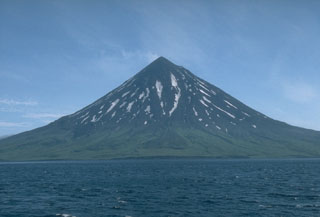Report on Cleveland (United States) — 17 May-23 May 2006
Smithsonian Institution / US Geological Survey
Weekly Volcanic Activity Report, 17 May-23 May 2006
Managing Editor: Sally Sennert.
Please cite this report as:
Global Volcanism Program, 2006. Report on Cleveland (United States) (Sennert, S, ed.). Weekly Volcanic Activity Report, 17 May-23 May 2006. Smithsonian Institution and US Geological Survey.
Cleveland
United States
52.825°N, 169.944°W; summit elev. 1730 m
All times are local (unless otherwise noted)
On 23 May, AVO reported that an astronaut aboard the International Space Station observed an ash plume from Cleveland at 1500. A plume was visible on satellite imagery at 1507 that drifted SW and reached a height of 6.1 km (20,000 ft) a.s.l. At 1700, an image showed the detached ash plume 130 km SW of Cleveland. The Concern Color Code was raised to Yellow. No precursory or current seismic information is available because Cleveland does not have a real-time seismic network.
Geological Summary. The beautifully symmetrical Mount Cleveland stratovolcano is situated at the western end of the uninhabited Chuginadak Island. It lies SE across Carlisle Pass strait from Carlisle volcano and NE across Chuginadak Pass strait from Herbert volcano. Joined to the rest of Chuginadak Island by a low isthmus, Cleveland is the highest of the Islands of the Four Mountains group and is one of the most active of the Aleutian Islands. The native name, Chuginadak, refers to the Aleut goddess of fire, who was thought to reside on the volcano. Numerous large lava flows descend the steep-sided flanks. It is possible that some 18th-to-19th century eruptions attributed to Carlisle should be ascribed to Cleveland (Miller et al., 1998). In 1944 it produced the only known fatality from an Aleutian eruption. Recent eruptions have been characterized by short-lived explosive ash emissions, at times accompanied by lava fountaining and lava flows down the flanks.
Source: US Geological Survey Alaska Volcano Observatory (AVO)

